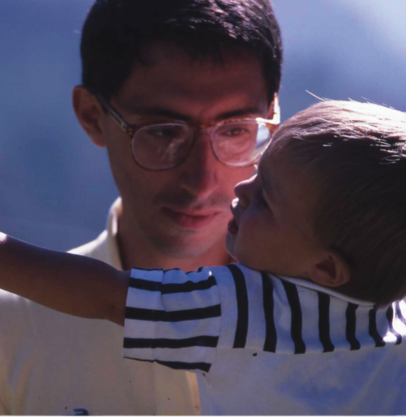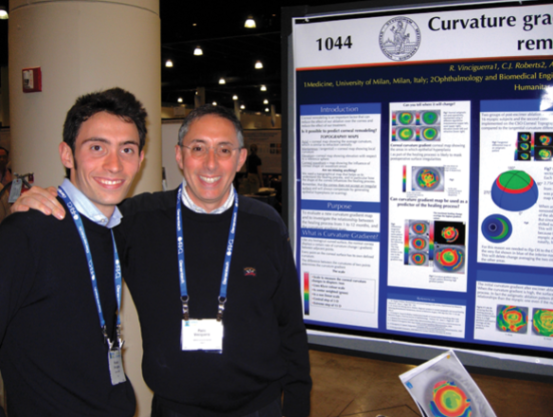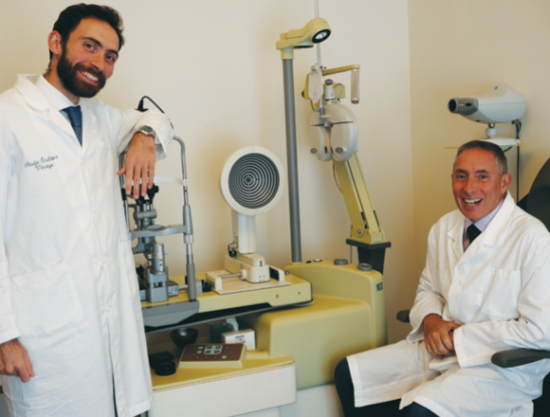No Longer Just A Scrubbed-and-Gowned Observer
By Paolo Vinciguerra, MD
When my son Riccardo was 4 years old, he decided he wanted to be an ophthalmologist; when he was 6, he began asking me to take him to the operating room as an observer whenever I was called to the hospital for an emergency. Just a few years later, he wanted to be a scrubbed-and-gowned observer during laser refractive surgery and PTK with intraoperative topography. He almost never changed his mind, and, sure enough, he went on to a successful career in ophthalmology.
I always had one fear: I did not want him to be a daddy’s boy, riding his father’s coattails. For this reason, during Riccardo’s years in medical school, I delegated to him a challenging project that I had never been able to publish in a peer-reviewed journal: the corneal curvature gradient. This project came from an intuition I had some years before, that an important driving force in corneal remodeling after any corneal surgery is a high difference in curvature between two adjacent points on the cornea. I had performed preliminary studies to assess whether this corneal curvature gradient hypothesis held water. Later, with Cynthia Roberts, PhD, I began to undertake a more robust study, but it was never published because it was a complicated topic.
Therefore, I had the idea that this could be the perfect opportunity to challenge Riccardo with a difficult task that would require not only clinical efforts but also mathematical knowledge and the ability to make the topic clear to the ophthalmic community. If he was successful, he would propose a mathematical model that has a clinical application in predicting the corneal healing process. Another challenge would be that Riccardo would have the need to interact not with me (too easy and not educational enough) but with Dr. Roberts, a prominent personality who is a scientist, not an ophthalmologist. He met this challenge, and he was indeed able to get the paper published rapidly.1
CHASING AFTER ANSWERS
In the process of his completing this project, I learned all about a new aspect of Riccardo’s personality. He is a tenacious man with a strong will, and, when he wishes to resolve a doubt or he needs clarification in the clinical area, he chases me until he gets all the answers. This means Saturday, Sunday, in the evening after dinner…
During this process, I had to perform a critical review of my own beliefs as well because he was not easily satisfied. In the ensuing years, as we continued our collaborations, I was often stimulated to improve my own procedures. One’s beliefs cannot always withstand critical discussion. It is similar to the process of submitting a paper to a peer-reviewed journal: When you submit the paper, it seems perfect, but when you start reading the reviewers’ criticisms you see the problems.
Subsequently, I followed the example of Batista “Pinin” Farina, the founder of Carozzeria Pininfarina, the famous Italian automobile firm. Batista entrusted his young son Sergio with the Ferrari account. He chose to challenge his son with the hardest work he could give him. In that spirit, I asked Riccardo to research and write some important papers:
- Long-term follow-up of CXL by age;2
- Predictive preoperative factors for better CXL outcomes;3
- CXL and iontophoresis;4-6 and
- Biomechanical screening for corneas at risk for ectasia before refractive surgery, which are frequently undetectable with topography or tomography.7,8
NO SHORTCUTS
Some years ago, I began performing laser-assisted cataract surgery (LACS). It was not easy to achieve better outcomes compared with standard phacoemulsification without wasting time. Riccardo was my assistant during these surgeries. He was always a stimulus, a sharp observer who was useful in the identification of weak points, and a partner able to discuss possible improvements in the technique. He never showed a complacent attitude or a lazy approach to the project. He was also helpful in the development of some surgical tricks for LACS that now are widely used in my country. I now know that, if I ask him to do something, it will be perfectly done, in time, with no shortcuts.
We also decided together that it would be a good idea for him to visit and observe Roberto Zaldivar, MD, and his son Roger for several months. Roberto and Roger are incredible surgeons, extremely innovative ophthalmologists, and warm hosts. Riccardo learned a great deal from them. (Editor’s Note: A family profile of the Zaldivars can be found on page 76.)
IMPROVING YOURSELF
In summary, my aim was to teach Riccardo what I learned from George O. Waring III, MD, FACS, FRCOphth—that knowledge has different levels. The first one is knowing how something should be done; the second is being able to do it; the third is being able to teach it to someone else; but the fourth, the maximum level, is being capable of writing it for publication in a scientific journal. This last step entails mastering all the previous levels, but it also requires that you submit the work to expert review, forcing you to read the literature regarding the topic in a critical way and consult the most prominent ophthalmologists in the field. This approach stimulates your attitude to improve yourself constantly.
1. Vinciguerra P, Roberts C, Albé E, et al. Curvature gradient map: a new corneal topography map to predict the corneal healing process. J Refract Surg. 2014;30(3):202-207.
2. Vinciguerra P, Romano V, Romano MR, Azzolini C, Vinciguerra R. Comment on, ‘Factors affecting outcomes of corneal collagen crosslinking treatment.’ Eye (Lond). 2014;28(8):1032-1033.
3. Vinciguerra R, Romano MR, Camesasca FI, et al. Corneal cross-linking as a treatment for keratoconus: four-year morphologic and clinical outcomes with respect to patient age. Ophthalmology. 2013;120:908-916.
4. Vinciguerra P, Mencucci R, Romano V, et al. Imaging mass spectrometry by matrix-assisted laser desorption/ionization and stress-strain measurements in iontophoresis transepithelial corneal collagen cross-linking. Biomed Res Int. 2014;2014:404587.
5. Vinciguerra P, Randleman JB, Romano V, et al. Transepithelial iontophoresis corneal collagen cross-linking for progressive keratoconus: initial clinical outcomes. J Refract Surg. 2014;30:746-753.
6. Vinciguerra P, Rechichi M, Rosetta P, et al. High fluence iontophoretic corneal collagen cross-linking: in vivo OCT imaging of riboflavin penetration. J Refract Surg. 2013;29:376-377.
7. Vinciguerra R, Elsheikh A, Roberts CJ, et al. Influence of pachymetry and intraocular pressure on dynamic corneal response parameters in healthy patients. J Refract Surg. 2016;32(8):550-561.
8. Vinciguerra R, Elsheikh A, Roberts CJ, et al. Detection of keratoconus with a new Corvis ST Biomechanical Index. J Refract Surg. In press.
Pushing the Limits
By Riccardo Vinciguerra, MD
Ever since I was a child (Figures 1 and 2), I dreamed of being an ophthalmologist. The first time I was admitted to an operating room—at only 6 years old—I watched my father doing laser surgeries. I remember that I was so short that the scrub outfit seemed like a dress. I also recall the moments of excitation, such as when a woman who had been a -10.00 D myope before LASIK screamed, “I can see!” and began to cry after her surgery.

Figure 1. Paolo with a young Riccardo.

Figure 2. A young Riccardo at play with his father.
When I started studying medicine, I never considered any other specialization. All my efforts were put toward ophthalmology. My father also helped me by introducing me to clinical research, and, when I was in my second year of medical school, in 2008, we worked together on my first poster as a first author at the Association for Research in Vision and Ophthalmology (ARVO). It was such a thrilling occasion for me. I remember how scared I was when we hung the poster in the hall (Figure 3). I was so young, but knowing that I had my mentor with me that day gave me the strength to stay there all day long, answering questions from interested visitors.

Figure 3. Riccardo’s first poster as first author, presented at ARVO in 2008.
A year later, we worked together with the Cornea Department of Humanitas University on an important article that was subsequently published in Ophthalmology.1 On that occasion, my father taught me how hard you have to work when you want to publish. I will always be grateful to him and to Elena Albé, MD, for their patience and support, even though I was still very slow in data collection.
THE MOMENT EVERYTHING CHANGED
Then everything changed. In the second semester of my third year of medical school, I began to rotate through other departments, and doubts began to grown in my mind: “Am I doing ophthalmology because I like it, or just because my father is doing it? Am I choosing it because I will probably have an easier life?”
To resolve these doubts, I did rotations in all kind of surgeries. I rotated through hand orthopedics, neurosurgery, general surgery, and, finally, heart surgery. In this last department, I spent almost 1 full year, and I was close to dedicating my life to cardiac surgery because of the emotion it gave me. On the other hand, I still liked ophthalmology a lot, even though it was so different from heart surgery.
At that time, in the early 2000s, many heart surgery specialists strongly advised me not to go into their profession because the indications were falling and they had fewer patients to operate on. Taking their advice, I decided to dedicate myself to eyes. Fortunately, I now know that I made the right decision.
In the ensuing years, I worked only rarely with my father. This was on purpose; we decided together that I needed a period to work away from him. We collaborated only on clinical research, not in clinical practice. That was an extremely important period of my life, during which I collaborated with my colleague and friend Mario Romano, MD, in the vitreoretinal department. Along with him I learned phacoemulsification, and, after a while, we also cooperated during clinics.
A FAMOUS EXAMPLE
Many colleagues and friends ask me, “How is it, working with your father? How do you manage the pressure of having such a famous example to emulate?” First of all, my father and I make a great team (Figure 4). We think and operate in the same ways. Usually, when I do something for him, he says I do it the way he would have done it. For this reason, we rarely have problems during clinics. On the other hand, in research we complement each other, and we are able to finalize manuscripts quite rapidly when we work together.

Figure 4. A recent photograph of Paolo and Riccardo.
Rather than feeling pressure to emulate him, I see his success only as an incentive to improve myself. I believe that, if you do not have a clever mentor to try to emulate, you will never push your own limits. However, in order to gain experience in other hospitals and to be able to see things and learn techniques I might not get working only with my father, I spent a period studying and learning abroad.
Currently, my father and I are entering a new phase of our working relationship, as I am working to improve myself in some fields my father has not worked in. Therefore, there are now areas in which my father has begun to ask for my advice, rather than the other way around. This is a nice development, and it tells me that I am probably working hard enough.
I believe that I have been lucky to have the possibility to work so closely and so well with my father. I hope that, some years from now, we will collaborate again.
1. Vinciguerra P, Albe E, Trazza S, et al. Refractive, topographic, tomographic, and aberrometric analysis of keratoconic eyes undergoing corneal cross-linking. Ophthalmology. 2009;116:369-378.


